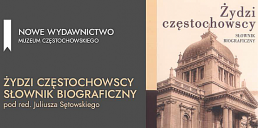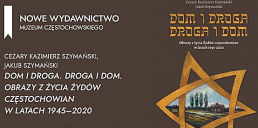Two New Books About Częstochowa Jewry
Pictures: Alon Goldman and the Częstochowa Municipal Museum
Two new books about the history of Częstochowa Jewry, in Polish, have just been published by the Częstochowa Municipal Museum and are now available for purchase.
To purchase eithere or both books, contact Ms. Magdalena Motyl at the Museum’s publishing house:
Email: wydawnictwa@muzeumczestochowa.pl (Polish and English) or telephone: +48-34-360-5631 (Polish)
The Jews of Częstochowa – a Biographical Dictionary, edited by Dr. Juliusz Sętkowski
This book won the 2020 Wolf & Dora Rajcher Memorial Award as judged by an academic panel from the Jan Długosz University of Częstochowa. The Award is presented annually, the prize for which covers the cost of the book’s publication.
It contains almost 600 biographies of Jews who were associated with Czestochowa in the 19th, 20th and early 21st centuries. It includes those who were born and lived permanently in Częstochowa, as well as those who were associated with the city for a short period or even several years. What determined their inclusion in the publication was their professional and creative activity or social service within the community. Some of the distinguished individuals in the directory were born in Częstochowa, but left at a young age and their contributions became well-known elsewhere – in Israel and abroad.
Included are profiles of Jews who were significant in the history of the city and the state. They include the names of Jews active in the economic, political, local, social, religious and scientific frields, as well as in education, health, law, sports, culture and art.
This book is the result of research by many people over many years – in archives, published bibliographies and press reports – as well as efforts to obtain information directly from families. The work makes extensive use of necrology, documenting information about deceased people, as well as broader memories describing the activities of a given person. Much information was taken from inscriptions engraved on the cemetery tombstones. The book makes use of the extensive material contained in the first volume of the cemetery book by Wiesław Paszkowski, “The Jewish Cemetery in Czestochowa”, which was published in Czestochowa in 2012.
Beginning from the late 1990’s, the author of these words documented the information in a biographical file of the Jews of Czestochowa. In 2006, after the establishment of the Czestochowa History Documentation Center (ODDC) at the Czestochowa Museum, the above file found its place there. As a result of numerous inquiries, the file was constantly expanded (it now has over 2,000 biographical cards). A separate file was created to accommodate Wiesław Paszkowski’s research on the Czestochowa Jewish community. This collected material, now in digital form, is also in the ODDC.
Most of the personalities in the directory are introduced for the first time. The authors in their work have attempted to supplement or amend the arrangements hitherto employed in biographical studies. In order to facilitate the use of the directory resources, along with a number of surnames that appear in the biographies, the sign → referring to the biographies of other people (relatives, business partners, friends) is displayed. At the end of each resume there is a bibliography that refers to relevant literature on the subject.
Droga i dom. Dom i Droga (The Road and Home. Home and the Road.) by Cezarek Kazimierz Szymanski and Jakub Szymanski
An excerpt from the introduction to the book, by Professor Jerzy Mizgalski of Jan Dlugosz University of Czestochowa, reads:
Pictures from the lives of Jews of Czestochowa, in the years 1945-2020, is the first comprehensive work which presents important and, at the same time, difficult research concerning the Jewish community in Czestochowa after World War II. The difficulty in this case is to reach widespread sources, to collect reports of generations of “survivors”, both those who remained in Częstochowa and those who are scattered all over the world. The authors achieved this.
The important value of the narrative, as presented by the authors, is in conveying to the contemporary reader facts in accordance with their objective interpretation, which expresses the interest of the entire Czestochowa community. Attempting to present, comprehensively and objectively, the history of the city after World War II is not easy. The variety of life experiences or political possibilities doubles the expectations for a narrative that is consistent with different areas of interest – political, national, social or individual. The authors’ indication of the fate of both Christians and Jews, during the difficult period of Nazi occupation and the process of rebuilding political and communal life after the War presents a picture of the socio-political diversity of Częstochowa and its inhabitants.
The value of this research assumes greater importance as a result of recording memories from those generations which, due to their age, have been taken from us and, along with them, much information from this tragic period in their lives.


